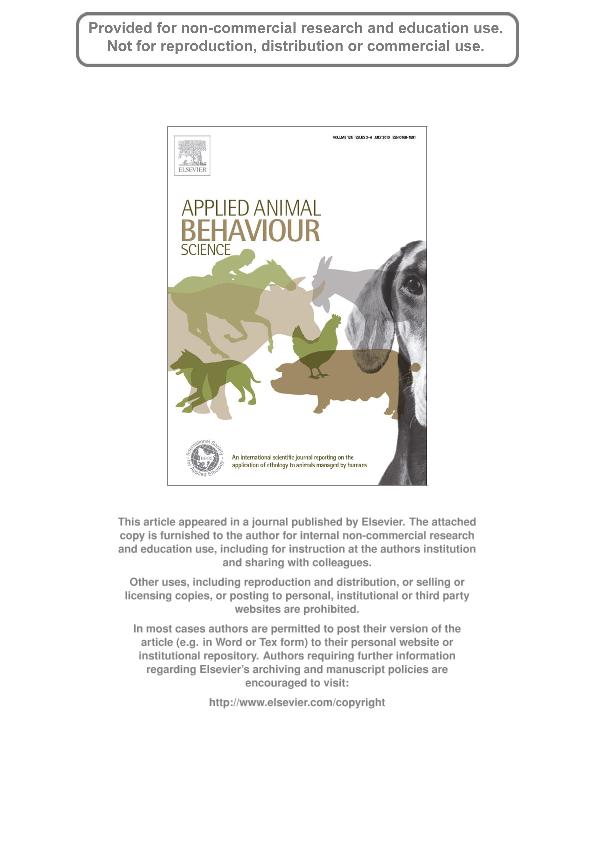Mostrar el registro sencillo del ítem
dc.contributor.author
Arzamendia, Yanina

dc.contributor.author
Bonacic, Cristian
dc.contributor.author
Vila, Bibiana Leonor

dc.date.available
2023-02-17T15:24:06Z
dc.date.issued
2010-07
dc.identifier.citation
Arzamendia, Yanina; Bonacic, Cristian; Vila, Bibiana Leonor; Behavioural and physiological consequences of capture for shearing of vicuñas in Argentina; Elsevier Science; Applied Animal Behaviour Science; 125; 3-4; 7-2010; 163-170
dc.identifier.issn
0168-1591
dc.identifier.uri
http://hdl.handle.net/11336/188406
dc.description.abstract
Behavioural, physical and physiological responses of Argentinean vicuñas to capture, handling and shearing were studied for the first time. The research was undertaken in a study area of 2414ha with a mean density of 12-40vicuñas/km 2. Captures were conducted on groups of wild vicuñas that had not received any prior management. Groups were herded into a funnel system that ended in a corral with several internal subdivisions. Three distinct capture methods were compared, according to the method by which the animals were herded into the corral (vehicles system: vehicles only; mixed system: people on foot and vehicles; and Chaku system: people on foot only). Attempts to escape, alarm calls, increased vigilance, vocalizations, and kicking were measured to quantify the stress response. A total of 478 vicuñas were captured between May 2003 and November 2005. Vicuñas captures by mixed system showed alert and active behaviours and vocalized more in the handling corral. The most active animals inside the corrals showed higher respiratory and heart frequency during handling (r=0.44, P<0.05 and r=0.58, P<0.001, respectively) and the heart rate increase was inversely proportional to blood glucose and creatin kinase (CK levels) (r=-0.31, P=0.05 and r=-0.4, P=0.05, respectively). Females captured by people on foot showed greater concentrations of cortisol (174±10.5nmol/L), compared to vicuñas captured by people and vehicles (127.38±12.5nmol/L) (F (1,21)=7.22, P<0.05). Cortisol levels peaked between 90 and 120min post-capture (♀=177.13±7.67nmol/L; ♂=135.11±13.23nmol/L). CK (ln) increased significantly according to time spent in captivity. The system that caused the fewest stress responses in vicuñas was capture by people on foot.
dc.format
application/pdf
dc.language.iso
eng
dc.publisher
Elsevier Science

dc.rights
info:eu-repo/semantics/openAccess
dc.rights.uri
https://creativecommons.org/licenses/by-nc-sa/2.5/ar/
dc.subject
CAPTURE
dc.subject
HANDLING
dc.subject
STRESS
dc.subject
VICUÑAS
dc.subject
WILD CAMELIDS
dc.subject.classification
Conservación de la Biodiversidad

dc.subject.classification
Ciencias Biológicas

dc.subject.classification
CIENCIAS NATURALES Y EXACTAS

dc.title
Behavioural and physiological consequences of capture for shearing of vicuñas in Argentina
dc.type
info:eu-repo/semantics/article
dc.type
info:ar-repo/semantics/artículo
dc.type
info:eu-repo/semantics/publishedVersion
dc.date.updated
2023-02-16T13:22:29Z
dc.journal.volume
125
dc.journal.number
3-4
dc.journal.pagination
163-170
dc.journal.pais
Países Bajos

dc.journal.ciudad
Amsterdam
dc.description.fil
Fil: Arzamendia, Yanina. Consejo Nacional de Investigaciones Científicas y Técnicas; Argentina. Universidad Nacional de Jujuy; Argentina
dc.description.fil
Fil: Bonacic, Cristian. Pontificia Universidad Católica de Chile; Chile
dc.description.fil
Fil: Vila, Bibiana Leonor. Universidad Nacional de Luján; Argentina. Consejo Nacional de Investigaciones Científicas y Técnicas; Argentina
dc.journal.title
Applied Animal Behaviour Science

dc.relation.alternativeid
info:eu-repo/semantics/altIdentifier/url/https://www.sciencedirect.com/science/article/abs/pii/S0168159110001346
dc.relation.alternativeid
info:eu-repo/semantics/altIdentifier/doi/http://dx.doi.org/10.1016/j.applanim.2010.04.013
Archivos asociados
